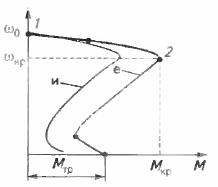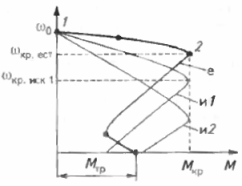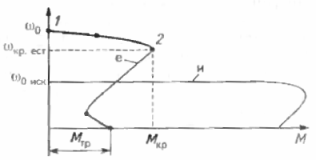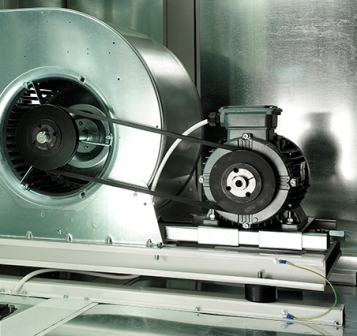Artificial mechanical characteristics of an induction motor
The artificial characteristics of the induction motor are obtained by changing the supply voltage, supply frequency, introducing additional resistances in the stator and rotor circuit.
Artificial mechanical characteristics obtained by changing the supply voltage. To build a working branch with artificial mechanical characteristics, consider two points. The first 1 point corresponds to the synchronous angular velocity, the second 2 — to the maximum (critical) moment (Fig. 1).

Rice. 1. Mechanical characteristics of the asynchronous motor when the mains voltage changes: e — natural characteristic at nominal mains voltage (Unom) and is an artificial characteristic at reduced mains voltage (Ufact = 0.9Unom); ωo — synchronous angular velocity; Mtr, Mkr — starting and critical moment of the engine, respectively.
The synchronous angular velocity of the induction motor is:
ωo = 2πf / p
As can be seen from this formula, the synchronous angular velocity does not depend on the voltage. Therefore, its position along the y-axis does not change.The second point has coordinates: critical moment and critical angular velocity. The critical angular velocity is independent of the voltage, and the critical moment is proportional to the square of the actual voltage, i.e. U2fact.
For example, if the mains voltage is reduced by 10%, the actual voltage will be 90%, or Uactual = 0.9Unom. Therefore, the critical moment on the artificial characteristic is proportional to
Mkr.isk ~U2fact ~ (0.9Unom)2 ~ 0.81U2fact
To find Mkr.isk, we will make up the proportion:
Mkr.est. ~U2nom;
Mkr.isk ~ 0.81U2fact.
Therefore:
Mkr.isk = Mkr.est. x (0.81U2actual/U2nom) = 0.81Mcr.
On the graph (see Fig. 1) we postpone the point corresponding to 81% of Mkr.est. and construction of an artificial mechanical characteristic.
Artificial mechanical characteristics obtained by introducing additional resistance in the rotor circuit of an induction motor with a wound rotor (R up to 6).
To create an artificial mechanical characteristic, consider two points (Fig. 2).

Rice. 2. Mechanical characteristics of the asynchronous motor when introducing additional resistance in the rotor circuit: e — calculated natural characteristic at Radd = 0; and 1 — artificial feature when Rext1 is not equal to 0; u2 — artificial characteristic in Radd2 > Rad1; ωcr.fed — critical angular velocity of the natural characteristic; ωcr.isk — the critical angular velocity of the artificial characteristic; M;tr, Starting torque of MCR and critical torque of the motor respectively.
Synchronous angular velocity (first point 1) is determined by the formula ωо = 2πf / p... It depends on the additional resistance. The first point therefore stands.The second point 2 has coordinates: moment is critical and velocity is critical.
The critical speed is inversely proportional to the added resistance and the critical moment is independent of the added resistance
The mechanical characteristics of this mode are shown in Figure 2. Artificial mechanical characteristics obtained by changing the frequency of the supply voltage. To construct an artificial mechanical characteristic, consider two points (Fig. 3).
The synchronous angular velocity (first point) is determined by the formula ωо = 2πf / p. It is directly proportional to the frequency of the supply voltage. Therefore, the first point will be shifted along the ordinate axis.
The second point has coordinates: moment is critical and velocity is critical. The critical speed is directly proportional to the frequency of the supply voltage and the critical moment is directly proportional to the square of the frequency of the supply voltage.
Figure 3 shows the natural and artificial mechanical characteristics of the induction motor with decreasing supply voltage frequency.

Rice. 3. Mechanical characteristics of an asynchronous motor with a reduction in power supply frequency: e — natural characteristic at 50 Hz and is an artificial characteristic at eisk at 0.5 ehranse; ωo — synchronous angular velocity of the natural characteristic; ω search — synchronous angular velocity of the artificial characteristic; ωcross — critical angular velocity of the natural characteristic; Mtr, Mkr — starting moment and critical moment of the engine, respectively.

